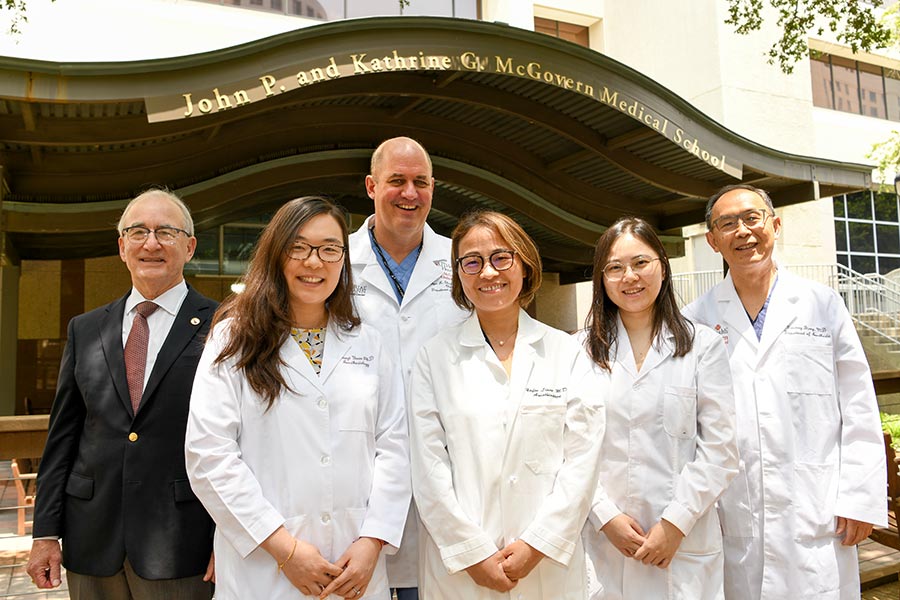Research sheds light on oxygen treatment for cardiovascular diseases

Collaborative research from two McGovern Medical School departments on the role of oxygen in cardiovascular disease treatment recently was published in Nature Reviews Cardiology (Impact Factor 49.4).
Basic scientists and clinicians from the departments of Anesthesiology, Critical Care and Pain Medicine and Internal Medicine reviewed multiple randomized controlled trials on the use of oxygen and cardiac injury to produce “Interplay of Hypoxia-Inducible Factors and Oxygen Therapy in Cardiovascular Medicine.”
Based on their review of recent large clinical trials on oxygen therapy during myocardial ischemia, cardiac arrest, heart failure, and cardiac surgery, the authors found that oxygen therapy does not have a universally safe dose range for different cardiovascular diseases.
Cardiovascular disease is frequently characterized by low oxygen availability (hypoxia). To reverse hypoxia, oxygen therapy has been used widely in cardiovascular medicine since the 1900s. Since oxygen is an odorless gas and does not cause any immediate side effects, liberal use of oxygen therapy is extremely common in various fields of medicine, such as acute coronary syndrome, chronic lung disease, or patients with acute respiratory distress syndrome.
Although essential to treat hypoxia, excessive oxygen supplementation can lead to harmful effects. Hyperoxia (a state of excess supply of oxygen in tissues and organs) can lead to coronary and cerebral vasoconstriction, exacerbate ischemia-reperfusion injury, cause central nervous system toxicity, and lead to absorption atelectasis and acute respiratory distress syndrome (ARDS).
“At a molecular level, hyperoxia is associated with the excessive production of reactive oxygen radicals and also dampens endogenous adaptive responses to hypoxia, including the stabilization of hypoxia-inducible transcription factors (HIFs), thereby exacerbating organ injury,” said Holger Eltzschig, MD, PhD, chair of the Department of Anesthesiology, Critical Care and Pain Medicine and holder of the John P. and Kathrine G. McGovern Distinguished University Chair.
“Like any other medication, hyperoxia resembles an overdose and is likely harmful,” wrote the authors Yafen Liang, MD, PhD; Wei Ruan, MD, PhD; Yandong Jiang, MD, PhD; Xiaoyi Yuan, PhD; and Eltzschig, PhD, MD, from the Department of Anesthesiology, Critical Care, and Pain Medicine, and Richard Smalling, MD, Division of Cardiovascular Medicine.
While hypoxia can be readily detected with pulse oximetry, hyperoxia is more challenging to monitor. “The maximal reading of 100 percent oxygen saturation (SpO2) correlates to a partial pressure of oxygen (PaO2) range of 100 to >663 mmHg at sea level,” explained Jiang, professor of anesthesiology, critical care and pain medicine. “Therefore, pulse oximetry cannot differentiate between a physiological PaO2 or iatrogenic hyperoxia. As a result, unintentional hyperoxia frequently occurs during oxygen therapy in patients with cardiovascular disease.”
Recent evidence from randomized controlled trials suggests that both maintaining acceptable oxygenation level and avoiding hyperoxia are essential for oxygen therapy in cardiovascular medicine, including acute myocardial infarction and post-cardiac arrest resuscitation.
“Nonetheless, a balanced oxygen treatment regimen to prevent systemic hypoxia and simultaneously avoid excessive hyperoxia has been an evolving treatment approach regardless of the clinical setting,” said Liang, corresponding and lead author of the paper
The research suggests alternative treatments to improve outcomes.
“Alternative approaches targeting oxygen-sensing pathways include preconditioning approaches or newly developed pharmacological agents that promote the stabilization of hypoxia-inducible factors; these therapeutic interventions are currently being developed for the treatment of cardiovascular disease and can be applied independently of the level of oxygen therapy that the patient is receiving,” Yuan said.
The authors noted their gratitude to Jagat Narula, MD, PhD, chief academic officer at UTHealth Houston, for his critical guidance and help in editing the review paper for submission to Nature Reviews Cardiology, the leading biomedical journal in cardiovascular medicine.